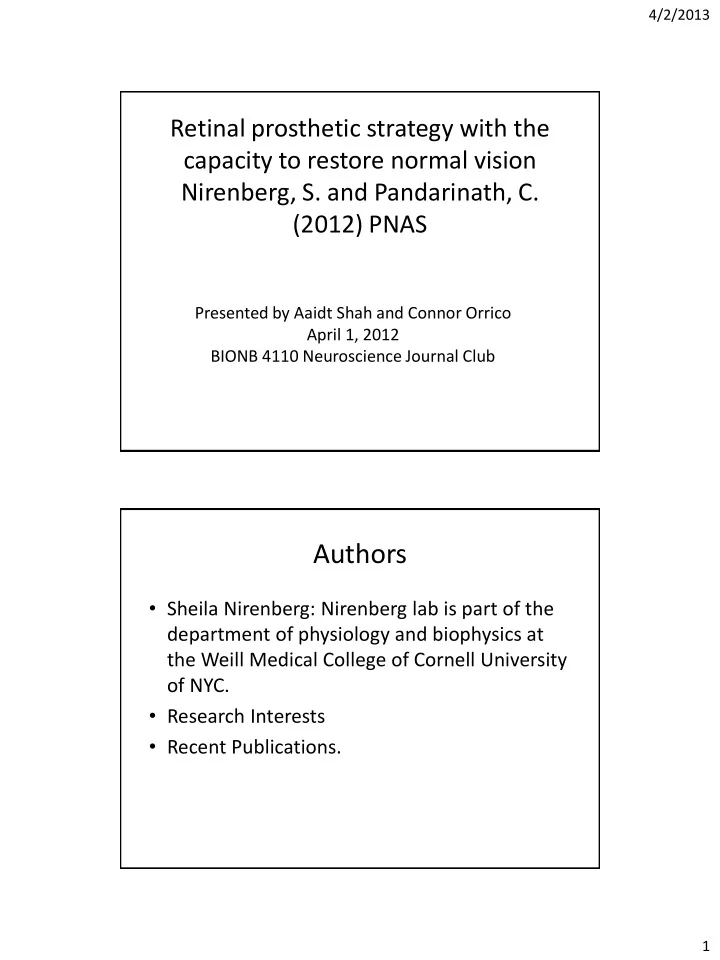

4/2/2013 Retinal prosthetic strategy with the capacity to restore normal vision Nirenberg, S. and Pandarinath, C. (2012) PNAS Presented by Aaidt Shah and Connor Orrico April 1, 2012 BIONB 4110 Neuroscience Journal Club Authors • Sheila Nirenberg: Nirenberg lab is part of the department of physiology and biophysics at the Weill Medical College of Cornell University of NYC. • Research Interests • Recent Publications. 1
4/2/2013 Chetan Pandarinath • Postdoctoral Fellow Nirenberg Lab Dept. of Physiology and Biophysics Weill Medical College of Cornell University • Ph.D., Electrical Engineering Cornell University, 2010 • Graduate Research : The Journal • The article is from the Proceedings of the National Academy of Sciences (PNAS) Journal of the United States. • Established in 1914 • One of the world’s most cited multidisciplinary scientific journals. • Published daily in online and weekly in print • Impact factor: 9.681 2
4/2/2013 Significance of the finding Retinal Prosthetic Devices Retinal Prosthetic devices • New form of Hope to be able HOPE 3
4/2/2013 The Problem • About 20-25 million people are affected world wide from such retinal degenerative diseases. • Examples of such diseases are Macular Degeneration Retinitis Pigmentosa. Normal Vision 4
4/2/2013 Retinal Degenration: What happens? Prosthetic Device 5
4/2/2013 Encoder • Retinal input/out device. • Mimics the transformations performed by the retina • Converts the visual input into the code used by the retinal output cells. • Firing rate at time t of the mth neuron in response to stimulus λ m (t) =N m ((S*L m )(t)) Encoder • Encoder is referred to as the complete encoding device • Essentially a model retina. • Arrays of smaller encoders, one for each ganglion type. • Example: separate smaller encoder for ON transient, on sustained etc. 6
4/2/2013 Stimulator and Transducer • Stimulator used is the mini DLP • Converts electrical pulses to light pulses • Transducer is the light sensitive protein ChR2 • Transducer drives ganglion cells to fire as the code specifies. The steps Fig. 1 from Nirenberg and Pandarinath (2012) 7
4/2/2013 Brief Outline Raw Data Confusion Matrices Image Reconstructions Behavioral Performance Raw Data • Presented movies – Natural, spatiotemporally varying scenes • Recorded ganglion cell responses using a multielectrode array 8
4/2/2013 9
4/2/2013 Functional Assay #1 • Confusion Matrices – Gives the probability that a neural response to a presented stimulus will be decoded as that stimulus • Elements on the diagonal indicate correct decoding • Elements off the diagonal indicate confusion 10
4/2/2013 11
4/2/2013 Functional Assay #2 • Image Reconstructions – Image presentation – Ganglion cell responses recorded • To obtain a large enough dataset for the complete reconstruction, the image was systemically moved across the region of the retina Blind Retina with standard optogenetic Original Encoder & Encoder prosthetic Image Blind Retina 12
4/2/2013 Functional Assay #3 • Behavioral Performance on a Optomotor Task – Animal was head-fixed – Liquid Crystal Display • LCD used instead of mini-DLP so that the eye-tracking system could be placed next to the eye – ISCAN tracking system tracked eye position by measurements of infrared reflections off the cornea 13
4/2/2013 Conclusions • “In sum, our results show that incorporating the code dramatically increases prosthetic capabilities. Although increasing resolutions also improves performance, there is an inherent ceiling on the quality of image this can produce; adding the code breaks through this barrier. The coded output combined with high-resolution stimulation makes natural vision restoration possible.”” 14
4/2/2013 Discussion • What is the most salient difference between the prosthetic approach in this paper and other optogenetic approaches? • Why were 9,800 ganglion cell responses used in this study? • In your opinion, how significant are these findings as related to vision problems in humans? 15
Recommend
More recommend